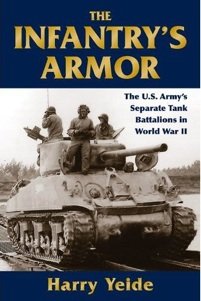The infantry’s armor
Click for PDF of all book images and citations
The author, Harry Yeide, set himself a daunting task since the separate battalions served in the Pacific, Africa, Italy, and Northwest Europe. The sheer volume of information really cries out for a set of separate books, limiting the degree to which the author can delve into details. The work also has to start with an overview of the creation of US tank forces in the 1930s as well as high-level background for each operation covered. However, Yeide manages to juggle this mix of general and specific subjects very well. . . . I certainly feel the two appendices and the bibliography make this book a “must” for WW2 enthusiasts.
Tom Cromwell, Armorama
The U.S. Army’s separate armored battalions in World War II labored in obscurity by comparison with the flashy armored divisions, but they overwhelming carried the heavier burden in the grim, global struggle to destroy the Axis Powers. The separate tank, amphibian tank, or amphibian tractor battalions were present at every amphibious assault that the Army conducted where armor was used at all, while armored divisions participated in landings only in North Africa and Sicily. The armored division played a preponderant combat role only in North Africa and Sicily. The separate battalions did most of the bloody work in Italy and constituted the entire effort in the Pacific. The respective roles were most equally balanced in Western Europe, and the separate tank battalions fought everywhere the infantry divisions did. The men fought beside the foot soldier in dust, mud, and sand. They were the dirt-grimed tankers, and this is their definitive history.
This work follows the armored battalions from the first battles against the Japanese in the Philippines and the landings in North Africa through the campaigns in the Mediterranean, Europe, and the Pacific. It breaks entirely new ground on the development of amphibious tactics using armor. It carefully traces the evolution of tank-infantry tactics and communications under conditions ranging from desert to mountains to cities to jungles. Parts of it cover ground originally addressed in Steel Victory (now out of print), but the material is extensively reworked with the addition of many new sources providing, among other things, considerably more on the infantry’s view, and much richer exploration of highlighted tactical battles, including Omaha Beach, the hedgerow fighting, and the fighting in the Battle of the Bulge. Chapters on the Pacific support the chronicle of events with detailed exploration of amphibious operations, doctrine, and development of tank-infantry cooperation. While armor generally worked in smaller packets in the Pacific than the other theaters, readers may be surprised to learn that there were more U.S. Army armored force men and vehicles committed to the landings on Saipan than at D-Day in France.
The Infantry’s Armor draws heavily on official after-action reports, observer reports, other contemporary combat records such as S-3 and G-3 journals, and interviews conducted by the Army with soldiers shortly after the actions occurred. Personal recollections written by tankers and veteran interviews round out the information. Illustrations come from official U.S. Army photographs. It includes 32 photographs, three tactical figures, and 31 maps, including tactical-level maps to support the text.
***
I wrote this book for several reasons. When I looked back at Steel Victory, it was very much a first book, and I found myself wishing that I had invested much more in examining the infantry side of the tank-infantry team. Added to this, the 2d Battalion, 5th Marines, helped me realize via the unit’s website and its critique of the earlier work that historical information on tank-infantry coordination could be highly relevant to today’s warrior, which influenced how I tackled this project. Second, no author had ever taken a good look at the tank battalions in North Africa, Sicily, and Italy. Third, no author had really explored how armor fit into the Pacific war in its predominant form as an amphibious conflict. That in turn got me wondering about why the use of tanks in amphibious operations in North Africa and Europe varied so wildly from landing to landing. And that got me curious about how the various theaters influenced one another in terms of tank-infantry tactics, communications solutions, and so on.
U.S. Army combat interviews; professional journal articles; and army, corps, division, and even regimental records added considerable fodder, including, for example, captured Japanese documents describing their antitank strategy on Okinawa. I had the great fortune to track down some additional veterans who were deeply involved in these affairs. David Redle fought with the 756th Tank Battalion in Italy and southern France and was one of the first Allied soldiers to enter Cassino. Ray Fleig fought with the 707th Tank Battalion, including at Kommerscheidt and with the 28th Infantry Division in the Bulge. Both retired officers were able to add granular details about how they fought and new dimensions to stories that have been told before. I also uncovered fascinating company and battalion histories plus veterans surveys of some of the Pacific theaters armored battalions that, so far as I can tell, have never been revealed before.
I hope you buy The Infantry’s Armor, because I think you will enjoy it.
